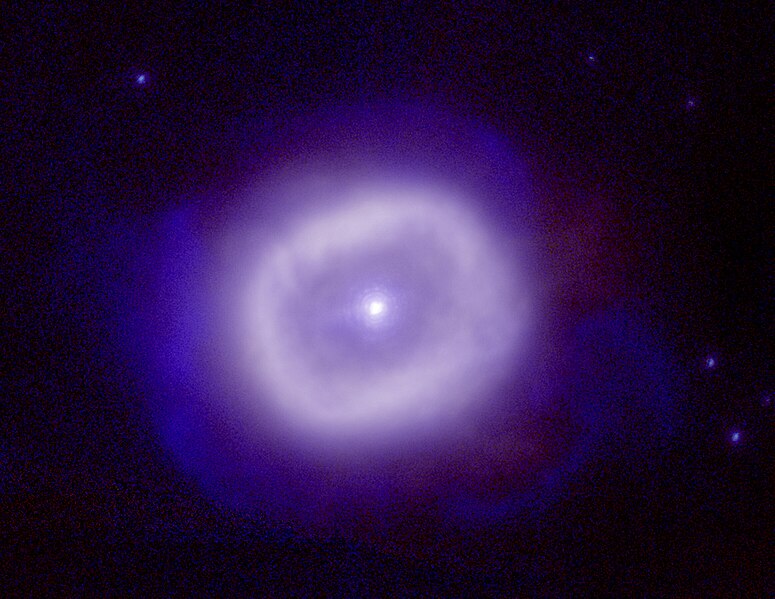File:Planetary nebula BD+303639 (noao-01g01r).jpg
From Wikimedia Commons, the free media repository
Jump to navigation
Jump to search

Size of this preview: 775 × 599 pixels. Other resolutions: 310 × 240 pixels | 621 × 480 pixels | 993 × 768 pixels | 1,280 × 990 pixels | 2,327 × 1,800 pixels.
Original file (2,327 × 1,800 pixels, file size: 1.24 MB, MIME type: image/jpeg)
File information
Structured data
Captions
Captions
This is a color composite infrared image using adaptive optics on the Gemini North telescope. The stellar images show remarkable resolution that approaches the theoretical limit for an 8 meter telescope. (Resolution = 0.
Summary[edit]
| DescriptionPlanetary nebula BD+303639 (noao-01g01r).jpg |
English: This is a color composite infrared image using adaptive optics on the Gemini North telescope. The stellar images show remarkable resolution that approaches the theoretical limit for an 8 meter telescope. (Resolution = 0.083 arc seconds FWHM) Other examples of the quality of Gemini North can be found in this image of NGC6934, and this image of G45.45+0.06. In this Gemini near infrared image the young planetary nebula known as BD+303639 is glowing in the light of hydrogen, the most abundant element in the universe. BD+303639 is about ten thousand light-years from the Earth in the direction of the constellation of Cygnus. A few million years ago BD+303639 was a star similar to our sun, but since then it has evolved, first into a "red giant", and then more rapidly into the planetary nebula seen today. In the "red giant" phase, the center of the star heats up and drives off its outer layers. In the subsequent Planetary Nebula phase, the ejected material is heated by ultraviolet radiation from the hot central star until it begins to glow. In a few tens of thousands of years (a short time by astronomical standards) the ejected material will be dispersed into the interstellar medium and the central star will slowly cool and eventually disappear. The bright box-like ring seen around the central star is due to emission from hydrogen in the material ejected during the red giant phase that has already been heated by the central star. This enormous shell would completely envelop our planetary system, being approximately one hundred times larger than our solar system. An unusual feature of this planetary nebula is the outer fainter and more wispy emission from molecular hydrogen. This larger shell of ejected material has yet to be broken apart by ultraviolet radiation from the star. The wispy structures visible in the light of molecular hydrogen reveals information about the extent of the ejected material and further details about the dynamic processes involved in recycling material from stars back into interstellar space. The sharpness of the star images, particularly apparent for the fainter stars around BD+303639, approaches the best image quality achievable with this size telescope at these wavelengths, promising a rich future of superb images from the Gemini telescopes. This image was taken by the Gemini North 8-meter telescope on Mauna Kea using the University of Hawaii's Adaptive Optics system called Hokupa'a. Adaptive Optics systems use deformable mirrors to correct for the effects of atmospheric distortions to starlight, resulting in significantly sharper images. It is expected that Adaptive Optics will allow Gemini to at times produce sharper images than is possible with the Hubble Space Telescope. For further information about the Gemini Observatory, please visit the Gemini WWW site. Photo Credit: Gemini Observatory, US National Science Foundation, and the University of Hawaii Institute for Astronomy. |
| Date | 30 June 2020, 21:34:00 (upload date) |
| Source | Planetary nebula BD+303639 |
| Author | International Gemini Observatory, US National Science Foundation, and the University of Hawaii Institute for Astronomy |
| Other versions |
|
Licensing[edit]
This media was created by the National Optical-Infrared Astronomy Research Laboratory (NOIRLab).
Their website states: "Unless specifically noted, the images, videos, and music distributed on the public NOIRLab website, along with the texts of press releases, announcements, images of the week and captions; are licensed under a Creative Commons Attribution 4.0 International License, and may on a non-exclusive basis be reproduced without fee provided the credit is clear and visible." To the uploader: You must provide a link (URL) to the original file and the authorship information if available. | |
This file is licensed under the Creative Commons Attribution 4.0 International license.
| |
File history
Click on a date/time to view the file as it appeared at that time.
| Date/Time | Thumbnail | Dimensions | User | Comment | |
|---|---|---|---|---|---|
| current | 19:22, 17 September 2023 |  | 2,327 × 1,800 (1.24 MB) | OptimusPrimeBot (talk | contribs) | #Spacemedia - Upload of https://noirlab.edu/public/media/archives/images/large/noao-01g01r.jpg via Commons:Spacemedia |
You cannot overwrite this file.
File usage on Commons
The following page uses this file:
Metadata
This file contains additional information such as Exif metadata which may have been added by the digital camera, scanner, or software program used to create or digitize it. If the file has been modified from its original state, some details such as the timestamp may not fully reflect those of the original file. The timestamp is only as accurate as the clock in the camera, and it may be completely wrong.
| Image title |
|
|---|---|
| Headline | None |
| Credit/Provider | International Gemini Observatory, US National Science Foundation, and the University of Hawaii Institute for Astronomy |
| Short title |
|
| Usage terms |
|
| Date and time of data generation | 21:34, 30 June 2020 |
| JPEG file comment | converted PNM file |
| Keywords | BD+303639 |
| Contact information |
None None, None, None None |
| IIM version | 4 |

